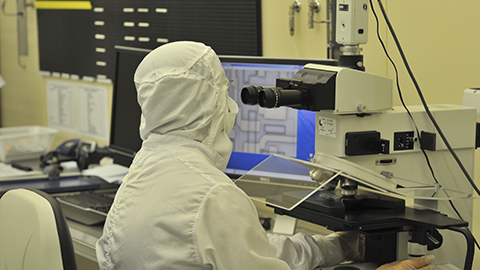Birth of Europe's largest network of nanoscience infrastructures

17/11/2015
Over the last ten years, Europe has invested some ten billion euros in nanoscience and nanotechnology laboratories all over the continent. Now, in order to optimise resources and stimulate collaborative research, the European Commission has approved the NFFA-Europe project, which aims to integrate these laboratories' capacities in nanoscience within the first global infrastructure for research in nanoscience.
The NFFA-Europe project brings together 20 institutions that pioneer research in this field, among them being synchrotrons, research centres and universities in Italy, France, Germany, Switzerland, Greece, Sweden, United Kingdom, Austria, Slovenia and Spain. The aim is to integrate their infrastructures and laboratories and make them available to a large number of researchers in various disciplines so that they can develop high-impact, innovative research projects. In this way the project seeks to create synergies to offer the best facilities for conducting research into the nanoscale properties of materials, both to academics and to companies.
Thanks to this initiative, researchers from all over Europe and from different disciplines will have access to the infrastructures they need to develop their project in all its phases, and with the most specific and precise methods: from developing theoretical models and numerical simulations with super-computers, to synthesising nanomaterials and different processes for manufacturing and characterising structures on the nano scale.
It is expected that during the project, which will last four years and have a budget of 10 million euros, around 1,000 users will benefit from its facilities and 350 research projects will be conducted there. The project partners will also jointly undertake research projects to develop new methods to increase precision in defining, transferring and positioning nanostructures, and allow the study on the nano scale of phenomena and processes (some of which are ultra-rapid) at the moment they occur. Furthermore, there will be programmes to train up a new generation of scientists from different disciplines, able to make effective use of the tools and methods needed in their research, and who will become advanced users of existing and future large-scale facilities.
Another priority of the project is to extend this potential to industry, for which reason NFFA-Europe will promote activities to inform businesses about these facilities and make them available, so that they can be used to innovate and create new products thanks to nanotechnology. For example, companies will be able to visit project members' facilities and carry out pilot projects there.
A transversal enabling technology
The NFFA-Europe project unites efforts to improve European competitiveness in nanoscience research: an important and expanding field within modern science. Its importance stems from the fact that it enables the creation of new innovations that could help to solve many of society's problems: diagnosis and treatment of illnesses, energy production and storage, food processing and conservation, environmental monitoring and protection, and even the conservation of the cultural heritage.
The resources of NFFA-Europe can help researchers everywhere to develop, for example, sensors that can detect a single molecule of a biomarker, nanomedicines for more effective therapies, new, more efficient photovoltaic cells, or smart packaging that can detect contamination in food in real time.
Open-access nanoscience data
One of the key features of NFFA-Europe is that it seeks to implement a common data-management policy among all partners and create a tool to compile all the information generated in the nanoscience research projects developed throughout the project. The aim is to create an open-access repository with all the standardised scientific data.
This tool would mean a very important step forward in the management of experimental nanoscience data, as it would allow researchers to consult, share and analyse the advances in this field.
State-of-the-art facilities in Catalonia
In Catalonia, six nanoscience and nanotechnology institutions are taking part in this project, among them being the Institute of Microelectronics of Barcelona (IMB-CNM, CSIC), the Institute of Materials Science of Barcelona (ICMAB CSIC), Universitat Autònoma de Barcelona (UAB), the UAB Research Park (PRUAB), the Catalan Institute for Nanoscience and Nanotechnology (ICN2) and the ALBA Synchrotron. They all belong to the Barcelona Nanocluster Bellaterra BNC-b.
The IMB-CNM, belonging to the Spanish National Research Council (CSIC) and located on the UAB's Bellaterra Campus, can place at the disposal of the project its advanced research equipment, for designing and producing new devices and materials with new mechanical, optical, electric or thermal properties. In addition, the IMB-CNM has 1500m2 of clean room space for micro- and nanomanufacturing: the largest in Spain. It is specially equipped for R&D+I projects that require silicon device and integrated-circuit technologies (chips) at all stages, from design and production to encapsulation and subsequent electrical and physical characterisation.
For its part, the UAB's contribution to the project is its capacity for training researchers, engineers and technologists, both from the university and industry, who are not familiar with nanotechnology research methods. Taking part are researchers from the Departments of Electronic Engineering and Physics, and from the Institute of Biotechnology and Biomedicine. Furthermore, the University offers its Microscopy Service, with its top-class staff and equipment.
The UAB Research Park is to play a key role in promoting collaboration between the research centres and industry, and in furthering the use of these state-of-the-art nanoscience infrastructures by Catalan companies.
NFFA-Europe can also count on the ALBA Synchrotron and on two research centres that have received the Severo Ochoa award for scientific excellence and are recognised internationally for their nanoscience and nanotechnology research: the Catalan Institute for Nanoscience and Nanotechnology (ICN2) and the Institute of Materials Science of Barcelona (ICMAB), another CSIC centre on the UAB's Bellaterra Campus. Both these centres have broad experience in research into nanomaterials and their properties, in synthesising bespoke nanostructures and in establishing new processes for designing and manufacturing nanodevices. The ALBA Synchrotron is a centre of excellence in synchrotron light that investigates and applies methods based on synchrotron light for R&D+I projects, contributing knowledge and value to the scientific and industrial communities.
Project website
http://www.nffa.eu/